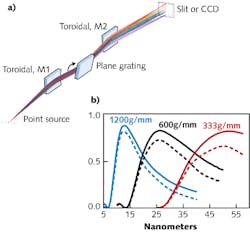SPECTROMETERS: Off-plane EUV spectrograph aids plasma research
Optical spectroscopy provides noninvasive data on impurities, ionization, temperature, and the formation and confinement properties of plasma useful for researchers. However, most flat-field and Rowland-circle spectrometers only produce one spectrum at the detector and require the addition of apertures or fiber-optic coupling to normal-incidence designs for imaging spectrograph studies. These add-ons result in limited wavelength range (optical fibers will not transmit at wavelengths less than 185 nm) or additional expense if numerous instruments are required at different sight lines from the plasma to collect multiple spectra simultaneously.
An alternative spectrometer design that provides broad-wavelength performance and simultaneous two-dimensional (2D) spectral/spatial imaging even in the extreme ultraviolet (EUV)—also called vacuum ultraviolet (VUV) or soft x-ray (XUV)—is an off-plane Czerny-Turner spectrograph. While the concept has been around for some time and these designs have been built in the lab by scientists, McPherson (Chelmsford, MA) has developed a commercial conical-diffraction, off-plane x-ray Czerny-Turner (OP-XCT) spectrograph that can be used, among other applications, for plasma diagnostics.
Off-plane architecture
Designed for operation from approximately 8 to 125 nm (10 to 150 eV), the OP-XCT can operate as a monochromator or imaging spectrograph. Illumination from a point source strikes an initial toroidal mirror (to reduce optical aberrations) at an 85° angle of incidence. This nearly grazing angle improves reflection efficiency at shorter wavelengths. Light then passes to a triple plane grating (three user-specified blaze wavelengths/groove densities can be selected) inside a vacuum vessel and then to the output toroidal mirror before passing through the exit slit.
Off-plane instruments have significantly higher diffraction-grating efficiency than comparable on-plane designs; experimental results have demonstrated that experimental high efficiencies follow modeled results (see figure). The plane gratings used in the OP-XCT are available with many different blaze angles and spectral resolution is a function of the gratings selected by the user and the entrance slit or source size. Focal length also directly influences attainable resolving power. With a 0.05 mm source and a CCD detector, the 800-mm-focal-length OP-XCT resolving power (λ/Δλ) measures higher than 300 at 25.6 nm (48 eV).
Placing a 2D detector at the exit focus allows the off-plane spectrometer to work as an imaging spectrograph. With a coarse diffraction grating installed, it can survey a very broad EUV wavelength swath from 10 to 140 nm on a detector approximately 12 mm wide.
A precision linear sine drive rotates the triple-grating mount and wavelength is tunable from below zero—where spectrometers pass integrated light—all the way to the visible spectral region when a suitably coarse grating is installed. The OP-XCT actually provides enough grating rotation to reach both positive and negative diffracted orders. The drive remains linear throughout for easy calibration using low-pressure mercury pen lamps, for example, and for calibration at air with wavelengths like 184.9 and 253.6 nm.
Currently, gratings with 4200 to 75 lines/mm are available. The most popular are 1200, 600, and 300 lines/mm (for wavelength ranges from 0–35, 0–75, and 0–140 nm, respectively), yielding 0.08, 0.16, and 0.32 nm full-width half-maximum (FWHM) resolution. Spectral reproducibility for a 1200 line/mm grating is ±0.005 nm.
Experimental analysis of a helium (He)-neon gas plasma using a 1200 line/mm grating with a 50 μm entrance slit and sampled by a CCD detector correctly revealed the 23.4, 23.7, 24.3, and 25.6 nm He II spectral lines for this sample. During another test, a 500 line/mm grating measured both neon emission lines at 73.6 and 74.4 nm and He emission lines around 58 nm. “The OP-XCT is ideal for EUV lithography research around 13 nm and high-energy laboratory experiments with lasers,” says McPherson scientific advisor Lori Krupa. “With fixed entrance and exit slit positions and an efficient grazing-incidence off-plane optical system, the design has low temporal broadening, good image formation, and uses easy to obtain diffraction gratings.” Krupa adds, “The 2D mode opens up a range of spatial diagnostic applications and it’s also useful as a monochromator with point-to-point imaging for high-harmonic laser generation experiments like photoemission and pump-probe spectroscopy.”

Gail Overton | Senior Editor (2004-2020)
Gail has more than 30 years of engineering, marketing, product management, and editorial experience in the photonics and optical communications industry. Before joining the staff at Laser Focus World in 2004, she held many product management and product marketing roles in the fiber-optics industry, most notably at Hughes (El Segundo, CA), GTE Labs (Waltham, MA), Corning (Corning, NY), Photon Kinetics (Beaverton, OR), and Newport Corporation (Irvine, CA). During her marketing career, Gail published articles in WDM Solutions and Sensors magazine and traveled internationally to conduct product and sales training. Gail received her BS degree in physics, with an emphasis in optics, from San Diego State University in San Diego, CA in May 1986.
